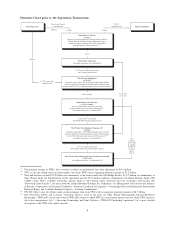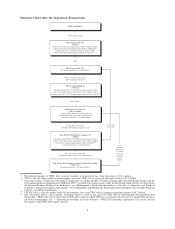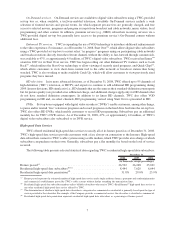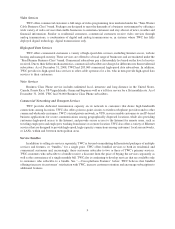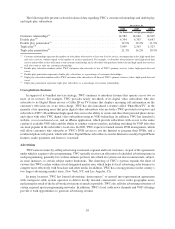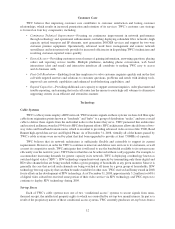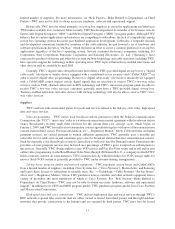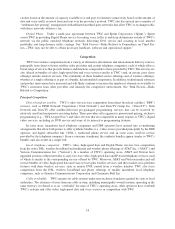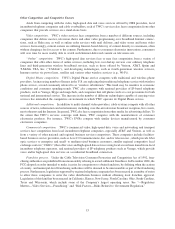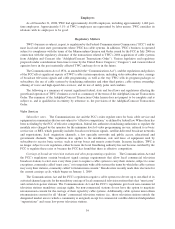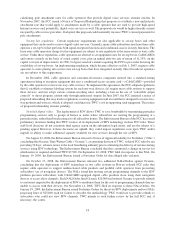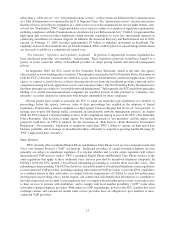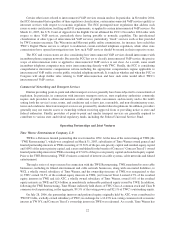Time Warner Cable 2008 Annual Report Download - page 22
Download and view the complete annual report
Please find page 22 of the 2008 Time Warner Cable annual report below. You can navigate through the pages in the report by either clicking on the pages listed below, or by using the keyword search tool below to find specific information within the annual report.Customer Care
TWC believes that improving customer care contributes to customer satisfaction and lasting customer
relationships, which results in increased penetration and retention of its services. TWC’s customer care strategy
is focused on four key components, including:
•Continuous Technical Improvement—Focusing on continuous improvement in network performance
through technology and operational enhancements, including deploying redundant fiber networks, high
capacity optical transport and IP elements, next generation DOCSIS services and support for two-way
customer premise equipment. Operationally, advanced work force management and remote network
surveillance and restoration tools provide for increased efficiencies in dispatching TWC’s technicians and
resolving customer-reported issues quickly;
•Ease of Access—Providing customers several means of gaining information, answering questions, placing
orders and reporting service trouble. Multiple platforms, including phone conversation, web based
interactions (chat and email) and interactive interfaces all contribute to making TWC easy to access
and do business with;
•First Call Resolution—Enabling front line employees to solve customer inquiries quickly and on the first
call with targeted answers and solutions to customer questions, problems and needs with desktop tools,
improved care network capabilities and enhanced troubleshooting capabilities; and
•Expand Capacities—Providing additional care capacity to support customer inquiries, order placement and
trouble reporting, and ensuring that each call center has the means to route high call volumes to alternative
supporting centers in an efficient and streamless manner.
Technology
Cable Systems
TWC’s cable systems employ a HFC network. TWC transmits signals on these systems via laser-fed fiber optic
cable from origination points known as “headends” and “hubs” to a group of distribution “nodes,” and uses coaxial
cable to deliver these signals from the individual nodes to the homes they serve. TWC pioneered this architecture
and received an Emmy award in 1994 for its HFC development efforts. HFC architecture allows the delivery of two-
way video and broadband transmissions, which is essential to providing advanced video services like VOD, Road
Runner high-speed data service and Digital Phone. As of December 31, 2008, virtually all of the homes passed by
TWC’s cable systems were served by plant that had been upgraded to provide at least 750MHz of capacity.
TWC believes that its network architecture is sufficiently flexible and extensible to support its current
requirements. However, in order for TWC to continue to innovate and deliver new services to its customers, as well
as meet its competitive needs, TWC anticipates that it will need to use the bandwidth available to its systems more
efficiently over the next few years. TWC believes that this can be achieved without costly upgrades. For example, to
accommodate increasing demands for greater capacity in its network, TWC is deploying a technology known as
switched digital video (“SDV”). SDV technology expands network capacity by transmitting only those digital and
HD video channels that are being watched within a given grouping of households at any given moment. Since it is
generally the case that not all such channels are being watched at all times by a given group of households, SDV
technology frees up capacity that can then be made available for other uses. TWC received an Emmy award in 2008
for its efforts in the development of SDV technology. As of December 31, 2008, approximately 5.2 million (or 60%)
of digital video subscribers received some portion of their video service via SDV technology, and TWC expects to
continue to deploy SDV technology during 2009.
Set-top Boxes
Each of TWC’s cable systems uses one of two “conditional access” systems to secure signals from unau-
thorized receipt, the intellectual property rights to which are controlled by set-top box manufacturers. In part as a
result of the proprietary nature of these conditional access systems, TWC currently purchases set-top boxes from a
12




